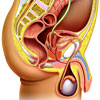New predictive model for erectile function after prostate cancer therapy
The development of prediction models that included variables such as pretreatment sexual function, patient characteristics and treatment factors appear to be effective at predicting erectile function 2 years after prostatectomy, external radiotherapy, or brachytherapy for prostate cancer, according to a study in the September 21 issue of JAMA.
“Because most patients survive early-stage prostate cancer after treatment, health-related quality of life (HRQOL) outcomes have emerged as a major emphasis in treatment decisions. Erectile dysfunction is commonplace after prostate cancer treatment and has significant consequences for HRQOL. Among urinary, bowel, vitality, and sexual HRQOL domains-outcomes commonly impaired by prostate cancer treatment-sexual function in previously potent men is the most commonly impaired and is closely related to outcome satisfaction,” the authors write. Information regarding how the combination of pretreatment patient characteristics and treatment factors relate to individualised sexual outcome remains limited.
Mehrdad Alemozaffar, M.D., of Beth Israel Deaconess Medical Center and Harvard Medical School, Boston, and colleagues conducted a study to determine whether an individual man’s sexual outcomes after the most common treatments for early-stage prostate cancer can be predicted accurately based on baseline characteristics and treatment plans. Information from an academic multicentre cohort (enrolled from 2003 through 2006), including pretreatment patient characteristics, sexual HRQOL, and treatment details, was used to develop models predicting erectile function 2 years after treatment. A community-based cohort (CaPSURE; enrolled 1995 through 2007) externally validated the performance of the model. Patients in U.S. academic and community-based practices whose HRQOL was measured pretreatment (n = 1,201) underwent follow-up after prostatectomy, external radiotherapy, or brachytherapy for prostate cancer. Sexual outcomes among men completing 2 years of follow-up (n = 1,027) were used to develop models predicting erectile function that were externally validated among 1,913 patients in a community-based cohort.
The researchers found that 2 years after treatment, 177 of 511 (35 percent) men who underwent prostatectomy reported the ability to attain functional erections suitable for intercourse; this corresponding figure was 37 percent (84 of 229) of men who had received external radiotherapy as their primary therapy; and 43 percent (107 of 247) of men who had received brachytherapy as primary treatment.
“Pretreatment sexual HRQOL score, age, serum prostate-specific antigen level, race/ethnicity, body mass index, and intended treatment details were associated with functional erections 2 years after treatment. Multivariable logistic regression models predicting erectile function estimated 2-year function probabilities from as low as 10 percent or less to as high as 70 percent or greater depending on the individual’s pretreatment patient characteristics and treatment details. The models performed well in predicting erections in external validation among CaPSURE cohort patients,” the authors write.
“We have developed clinically applicable models to predict recovery of erectile function following prostatectomy, external radiotherapy, or brachytherapy for early-stage prostate cancer based on pretreatment sexual function, patient characteristics, and specific plan of treatment. External validation of this predictive model in a community-based cohort suggests that these findings are generalisable and may help physicians and patients to set personalised expectations regarding prospects for erectile function in the years following primary treatment for prostate cancer,” the researchers conclude.
(Source: JAMA/Archives: JAMA)
More information
 | For more information on erectile dysfunction, types, causes and treatments of erectile dysfunction, and tips for dealing with it, see Erectile Dysfunction. |
 | For more information on prostate cancer, including diagnoses, types of treatments, and some useful tools, videos and animations, see Prostate Cancer. |
Dates
Tags
Created by:

 Login
Login














